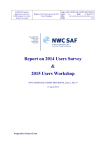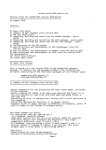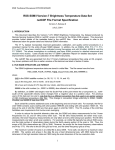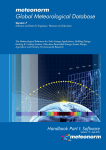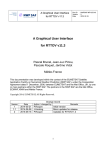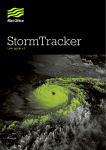Download Product User Manual Fundamental Climate Data Record of SSM/I
Transcript
EUMETSAT Satellite Application Facility on Climate Monitoring Product User Manual Fundamental Climate Data Record of SSM/I Brightness Temperatures CM-150 FCDR_SSMI Reference Number: Issue/Revision Index: Date: SAF/CM/DWD/PUM/FCDR_SSMI 0.1 17.04.2012 EUMETSAT SAF on CLIMATE MONITORING Product User Manual FCDR SSM/I Brightness Temperatures Doc.No.: Issue: Date: SAF/CM/DWD/PUM/FCDR_SSMI 0.1 17.04.2012 Document Signature Table Name Function Signature Author Karsten Fennig CM SAF scientist Editor Rainer Hollmann Science Coordinator Approval Rainer Hollmann Science Coordinator Release Martin Werscheck Project Manager Date 2012-04-17 Distribution List Internal Distribution Name No. Copies DWD Archive 1 CM SAF Team 1 External Distribution Company Name No. Copies PUBLIC 1 Document Change Record Issue/ Revision Date DCN No. Changed Pages/Paragraphs 0.1 2012-04-17 SAF/CM/DWD/PUM/FCDR_SSMI Document under progress 2 EUMETSAT SAF on CLIMATE MONITORING Product User Manual FCDR SSM/I Brightness Temperatures Doc.No.: Issue: Date: SAF/CM/DWD/PUM/FCDR_SSMI 0.1 17.04.2012 Table of Contents List of Figures 3 List of Tables 3 1 The EUMETSAT SAF on Climate Monitoring 4 2 Introduction 4 2.1 Applicable documents 5 2.2 Reference documents 5 3 The SSM/I Instrument 5 4 Product definitions 6 5 Data format description 6 5.1 Data file contents 6 7 Data ordering via the Web User Interface (WUI) 12 6.1 Product ordering process 12 6.2 Contact User Help Desk staff 12 6.3 Feedback/User Problem Report 12 6.4 Service Messages / log of changes 12 7 References 13 8 Glossary 14 9 Appendix A 15 List of Figures Figure 1: SSM/I scan geometry (from Hollinger et al., 1987). ............................................................................6 List of Tables Table 1: Global NetCDF attributes. ..................................................................................................................15 Table 2: Attributes assigned to variables. ........................................................................................................16 3 EUMETSAT SAF on CLIMATE MONITORING Product User Manual FCDR SSM/I Brightness Temperatures Doc.No.: Issue: Date: SAF/CM/DWD/PUM/FCDR_SSMI 0.1 17.04.2012 1 The EUMETSAT SAF on Climate Monitoring The importance of climate monitoring with satellites was recognized in 1999 by EUMETSAT Member States when they amended the EUMETSAT Convention to affirm that the EUMETSAT mandate is also to contribute to the operational monitoring of climate and the detection of global climatic changes". Following this, EUMETSAT established within its Satellite Application Facility (SAF) network a dedicated centre, the SAF on Climate Monitoring (CM SAF, http://www.cmsaf.eu). Since the start of the CM SAF in 1999 the project went through three phases, i.e., the Development Phase lasting from 1999 to 2004, the Initial Operations Phase (IOP) and the Continued Development and Operations Phase (CDOP). The consortium of CM SAF currently comprises the Deutscher Wetterdienst (DWD) as host institute, and the partners from the Royal Meteorological Institute of Belgium (RMIB), the Finnish Meteorological Institute (FMI), the Royal Meteorological Institute of the Netherlands (KNMI), the Swedish Meteorological and Hydrological Institute (SMHI) and the Meteorological Service of Switzerland (MeteoSwiss). After focusing on the development of retrieval schemes to derive a subset of Essential Climate Variables (ECVs) in the development phase, CM SAF delivered to its users products based on Meteosat and polar orbiter data for Europe and Northern Africa supporting NMHSs in their provision of climate services in the IOP from 2004 to 2007. During CDOP, lasting from 2007 to 2012, the product validation continued, the time series were expanded and algorithms were further improved, while the study domain was extended from the baseline area to the MSG disk for the geostationary products and to include global and Arctic coverage for the polar orbiter products. In addition, long term climate datasets from polar orbiting and geostationary satellites are being generated for climate monitoring (i.e. HOAPS, METEOSAT and AVHRR-GAC based products). A catalogue of available CM SAF products is available via the CM SAF webpage, http://www.cmsaf.eu/. Here, detailed information about product ordering, add-on tools, sample programs and documentation are provided. 2 Introduction This CM SAF Product User Manual (PUM) provides information on the Fundamental Climate Data Record (FCDR) of Brightness Temperatures from the Special Sensor Microwave/Imager (SSM/I). The predecessors of this data record and the data processor suite have originally been developed at the Max-Planck Institute for Meteorology (MPI-M) and the University of Hamburg (UHH) for the Hamburg Ocean Atmosphere Parameters and Fluxes from Satellite Data (HOAPS, http://www.hoaps.org/) climatology. HOAPS is a compilation of climate data records for analysing the water cycle components over the global oceans derived from satellite observation (Andersson et al. 2011). The main satellite instrument employed to retrieve the geophysical parameters is the SSM/I and much work has been invested to process and carefully homogenize all SSM/I instruments onboard the Defence Meteorological Satellite Program (DMSP) platforms F08, F10, F11, F13, F14 and F15 (Andersson et al. 2010). A technical description of the data sets including information on the file format as well as on the data access is provided in this document. Furthermore details on the implementation of the processing chain and individual processing steps are available in the Algorithm Theoretical Basis Document [RD 2]. Basic accuracy requirements are defined in the product requirements document [AD 2]. A detailed validation of the FCDR is available in the Validation report [RD 3]. 4 EUMETSAT SAF on CLIMATE MONITORING Product User Manual FCDR SSM/I Brightness Temperatures 2.1 SAF/CM/DWD/PUM/FCDR_SSMI 0.1 17.04.2012 Applicable documents Reference Title AD 1 Memorandum of Understanding between CM SAF and the Max-Planck Institute for Meteorology and Meteorological Institute, University of Hamburg AD 2 Cooperation Agreement 2.2 Doc.No.: Issue: Date: Code Reference documents Reference Title Code RD 1 CM SAF Product Requirements Document SAF/CM/DWD/PRD/1.6 RD 2 Algorithm Theoretical Basis Document Fundamental Climate Data Record of SSM/I Brightness Temperatures SAF/CM/DWD/ATBD/FCDR_SSMI/1.0 RD 3 Validation Report Fundamental Climate Data Record of SSM/I Brightness Temperatures SAF/CM/DWD/VAL/FCDR_SSMI/1.0 3 The SSM/I Instrument SSM/I sensors have been carried aboard the DMSP satellite series since 1987. Up to three radiometers have been in orbit simultaneously. An extensive description of the instrument and satellite characteristics has been published by Hollinger (1987) and Wentz (1991). Hence, only a short summary of essential information is given here. The DMSP satellites operate in a nearcircular, sun-synchronous orbit, with an inclination of 98.8° at an approximate altitude of 860 km. Each day, 14.1 orbits with a period of about 102 minutes are performed. The Earth’s surface is sampled with a conical scan at a constant antenna boresight angle of 45° over an angular sector of 102.4° resulting in a 1400 km wide swath on the Earth surface (Figure 1). A nearly complete coverage of the Earth by one SSM/I instrument is achieved within two to three days. Due to the orbit inclination and swath width, the regions poleward of 87.5° are not covered. To date, six SSM/I instruments have been successfully launched aboard the F08, F10, F11, F13, F14 and F15 spacecrafts. All satellites have a local equator crossing time between 5 and 10 A.M./P.M. for the descending/ascending node. The F08 had a reversed orbit with the ascending node in the morning. Also, the Earth observing angular sector of the scan on this satellite is, differently from the others, centred to the aft of the sub-satellite track. Most of the DMSP satellites have a stable orbit. The temporal variation of the equator crossing times is less than three hours for all satellites. At the end of the time period the orbits of F14 and F15 begin to decay noticeably, but are still within 2-3 hours of original time. The SSM/I is a seven channel total power radiometer measuring emitted microwave radiation at four frequency intervals centred at 19.35, 22.235, 37.0, and 85.5 GHz. All frequencies are sampled at horizontal and vertical polarization, except for the 22.235 GHz channel, which measures only vertically polarized radiation. The channels will be referred to as 19, 22, 37, and 85 GHz hereafter and the corresponding brightness temperatures of each channel and polarization as TB19v/h, TB22v, TB37v/h, and TB85v/h. The spatial resolution varies from 69 km by 43 km with a sampling frequency of 25 km for the 19 GHz channel to 15 km by 13 km with 12.5 km sampling frequency for the 85 GHz channel. The 5 EUMETSAT SAF on CLIMATE MONITORING Product User Manual FCDR SSM/I Brightness Temperatures Doc.No.: Issue: Date: SAF/CM/DWD/PUM/FCDR_SSMI 0.1 17.04.2012 Figure 1: SSM/I scan geometry (from Hollinger et al., 1987). 85 GHz channels are sampled for each rotation of the instrument (A and B-scans) with a resolution of 128 uniformly spaced pixels, while the remaining channels are sampled every other scan (A-scans) with a resolution of 64 pixels (see Figure 1). A fixed cold space reflector and a reference black body hot load are used for continuous onboard two point calibration. 4 Product definition The CM SAF FCDR from SSM/I brightness temperatures are compiled as daily collections of all observations from one sensor. All sensor specific data available in the raw data records are provided as well as additional information like quality control flags, Earths incidence angles, averaged 85 GHz brightness temperatures, incidence angle normalisation offsets and inter-sensor calibration offsets. 5 Data format description The CM SAF FCDR dataset is provided as NetCDF (Network Common Data Format) files (http://www.unidata.ucar.edu/software/netcdf/). The data files are compiled following NetCDF 6 EUMETSAT SAF on CLIMATE MONITORING Product User Manual FCDR SSM/I Brightness Temperatures Doc.No.: Issue: Date: SAF/CM/DWD/PUM/FCDR_SSMI 0.1 17.04.2012 Climate and Forecast (CF) Metadata Convention version 1.5 (http://cf-pcmdi.llnl.gov/) and NetCDF Attribute Convention for Dataset Discovery version 1.0. All SSM/I FCDR products files are swath based and built following the same design principles. The record dimension of the data files is the B-scan integer time measured in seconds since 1st January 1987. Each file contains all possible scans for one complete day (~ 22749 scans) regardless of their quality and status. Missing scans are marked as missing and sensor data are set to undefined in this case. The users are advised to read and apply the supplied quality control flags qc_scan, qc_channel, qc_fov_lo and qc_fov_hi in order to filter incorrect and erroneous observations. The quality control procedure and thresholds are described in the ATBD [RD 2]. To account for the higher 85GHz channels sampling (see section 3), an additional dimension scan_type is used keeping the same record dimension as for the low resolution channels. This keeps the file format compatible to the original NOAA/NESDIS format and results in a 4-dimensional array for the 85GHz channel brightness temperatures: [time, scan_type, channel_hifreq, across_track]. The observation time of the A-scan can be calculated by subtracting 60/rotation (~1.9 s) from the B-scan time. The FOV positions of the high and low resolution channels are co-registered. To get the FOV position of the lower resolution channel the across_track_lores coordinate variable can be used as an index to the A-scan position arrays: lat_lores = lat[time, 0, across_track_lores] This follows the CF convention for compression by gathering and the corresponding attribute compress is assigned to the coordinate variable across_track_lores. Daily mean values have a fixed dimension date of size 1. 5.1 Data file contents A common NetCDF file consists of dimensions, variables, and attributes. These components can be used together to capture the meaning of data and relations among data. Global attributes are summarized in Table 1 and possible variable attributes in Table 2 (Appendix A). The following variables (thematically sorted) are available in the FCDR data files: Coordinate variables date Validity date [days counted from 1987-01-01 00:00:00 UTC] Fixed dimension [1] time B-Scan start time [seconds counted from 1987-01-01 00:00:00 UTC] Record dimension across_track FOV across track position of high resolution channels Fixed dimension [128] across_track_lores FOV across track position of low resolution channels Fixed dimension [64] compress = across_track 7 EUMETSAT SAF on CLIMATE MONITORING Product User Manual FCDR SSM/I Brightness Temperatures Doc.No.: Issue: Date: channel Channel number Fixed dimension [7] channel_hifreq Channel number of high frequency channels Fixed dimension [2] compress = channel Explanatory variables channel_name String representation of the corresponding channel number. [“V19”, “H19”, “V22”, “V37”, “H37”, “V85”, “H85”] scan_type_name String representation of the corresponding scan type. [“A”, “B”] Daily mean statistical variables rotation instrument rotational speed [rpm] dimension [date] hotc_var variance of hot load reading [count^2] dimension [date, channel] colc_var variance of cold load reading [count^2] dimension [date, channel] trhl_var variance of hot load temperature [K^2] dimension [date] nedt noise equivalent temperature [K] dimension [date, channel] Quality control variables qc_scan Scanline quality control [bit mask] dimension [time] All bits set to 0 indicates normal condition. qc_channel Channel quality control [bit mask] dimension [time, channel] All bits set to 0 indicates normal condition. 8 SAF/CM/DWD/PUM/FCDR_SSMI 0.1 17.04.2012 EUMETSAT SAF on CLIMATE MONITORING Product User Manual FCDR SSM/I Brightness Temperatures Doc.No.: Issue: Date: SAF/CM/DWD/PUM/FCDR_SSMI qc_fov_lo Field of view quality control, low-resolution [bit mask] dimension [time, across_track_lores] All bits set to 0 implies acceptable data. qc_fov_hi Field of view quality control, high-resolution [bit mask] dimension [time, across_track] All bits set to 0 implies acceptable data. Geolocation variables tfrac B-scan micro seconds [10^-6 s] dimension [time] To get the exact scan time add this to time. lat FOV latitude [degree_north] dimension [time, scan_type, across_track] lon FOV longitude [degree_east] dimension [time, scan_type, across_track] laz FOV local azimuth angle [degree_east] dimension [time, across_track] sft_lo FOV surface type for low resolution channels dimension [time, across_track_lores] Possible types are: water, land, coast, sea_ice, sea_ice_edge sft_hi FOV surface type for high resolution channels dimension [time, scan_type, across_track] Possible types are: water, land, coast, coast2, sea_ice, sea_ice_edge rev Revolution number dimension [time] salt Altitude of spacecraft [km] dimension [time] slat Latitude of spacecraft sub satellite point [degree_north] dimension [time] slon Longitude of spacecraft sub satellite point [degree_east] dimension [time] 9 0.1 17.04.2012 EUMETSAT SAF on CLIMATE MONITORING Product User Manual FCDR SSM/I Brightness Temperatures eia Earth incidence angle [degree] dimension [time] Calibration and sensor state variables slope Calibration slope [K/count] dimension [time, channel] offset Calibration offset [K] dimension [time, channel] trhl Hot load temperature [K] dimension [time, nread] trfr Forward radiator temperature [K] dimension [time] trrf R.F. mixer temperature [K] dimension [time] hotc Hot load reading [count] dimension [time, scan_type, channel, nload] colc Cold load reading [count] dimension [time, scan_type, channel, nload] rvolt Reference voltage dimension [time, nread] agc Automatic gain control setting dimension [time, scan_type, channel] md5 MD5 message digest dimension [time, ndigest] Sensor data variables tb Brightness temperature [K] dimension [time, channel, across_track_lores] ical Brightness temperature intercalibration offset [K] dimension [time, channel, across_track_lores] 10 Doc.No.: Issue: Date: SAF/CM/DWD/PUM/FCDR_SSMI 0.1 17.04.2012 EUMETSAT SAF on CLIMATE MONITORING Product User Manual FCDR SSM/I Brightness Temperatures Doc.No.: Issue: Date: SAF/CM/DWD/PUM/FCDR_SSMI eia_norm Brightness temperature earth incidence angle normalization offset [K] dimension [time, channel, across_track_lores] tb_hi Brightness temperature, 85GHz [K] dimension [time, scan_type, channel_hifreq, across_track] ical_hi Brightness temperature intercalibration offset, 85GHz [K] dimension [time, scan_type, channel_hifreq, across_track] 11 0.1 17.04.2012 EUMETSAT SAF on CLIMATE MONITORING Product User Manual FCDR SSM/I Brightness Temperatures Doc.No.: Issue: Date: SAF/CM/DWD/PUM/FCDR_SSMI 0.1 17.04.2012 6 Data ordering via the Web User Interface (WUI) User services are provided through the CM SAF homepage www.cmsaf.eu. The user service includes information and documentation about the CM SAF and the CM SAF products, information on how to contact the user help desk and allows to search the product catalogue and to order products. On the main webpage, a detailed description how to use the web interface for product search and ordering is given. We refer the user to this description since it is the central and most up to date documentation. However, some of the key features and services are briefly described in the following sections. Copyright note: All intellectual property rights of the CM SAF products belong to EUMETSAT. The use of these products is granted to every interested user, free of charge. If you wish to use these products, EUMETSAT's copyright credit must be shown by displaying the words "copyright (year) EUMETSAT" on each of the products used 6.1 Product ordering process You need to be registered and logged in to order products. A login is provided upon registration, all products are delivered free of charge. After the selection of the product, the desired way of data transfer can be chosen. This is either via a temporary ftp account (the default setting), or by CD/DVD or email. Each order will be confirmed via email, and the user will get another email once the data have been prepared. If the ftp data transfer was selected, this second email will provide the information on how to access the ftp server. 6.2 Contact User Help Desk staff In case of questions the contact information of the User Help Desk (e-mail address [email protected], telephone and fax number) are available via the CM SAF main webpage (www.cmsaf.eu) or the main page of the Web User Interface. 6.3 Feedback/User Problem Report Users of CM SAF products and services are encouraged to provide feedback on the CM SAF product and services to the CM SAF team. Users can either contact the User Help Desk (see chapter 6.2) or use the “User Problem Report” page. A link to the “User Problem Report” is available either from the CM SAF main page (www.cmsaf.eu) or the Web User Interface main page. 6.4 Service Messages / log of changes Service messages and a log of changes are also accessible from the CM SAF main webpage (www.cmsaf.eu) and provide useful information on product status, versioning and known deficiencies. 12 EUMETSAT SAF on CLIMATE MONITORING Product User Manual FCDR SSM/I Brightness Temperatures Doc.No.: Issue: Date: SAF/CM/DWD/PUM/FCDR_SSMI 0.1 17.04.2012 7 References Andersson, Axel; Bakan, Stephan; Fennig, Karsten; Grassl, Hartmut; Klepp, Christian-Phillip; Schulz, Joerg: Hamburg Ocean Atmosphere Parameters and Fluxes from Satellite Data HOAPS-3 - monthly mean., electronic publication, World Data Center for Climate, doi:10.1594/WDCC/HOAPS3_MONTHLY, 2007a. Andersson, Axel; Bakan, Stephan; Fennig, Karsten; Grassl, Hartmut; Klepp, Christian-Phillip; Schulz, Joerg: Hamburg Ocean Atmosphere Parameters and Fluxes from Satellite Data HOAPS-3 - 5-days mean., electronic publication, World Data Center for Climate, doi:10.1594/WDCC/HOAPS3_PENTAD, 2007b. Andersson, Axel; Bakan, Stephan; Fennig, Karsten; Grassl, Hartmut; Klepp, Christian-Phillip; Schulz, Joerg: Hamburg Ocean Atmosphere Parameters and Fluxes from Satellite Data HOAPS-3 - twice daily composite., electronic publication, World Data Center for Climate, doi:10.1594/WDCC/HOAPS3_DAILY, 2007c. Andersson, A., Fennig, K., Klepp, C., Bakan, S., Graßl, H., and Schulz, J.: The Hamburg Ocean Atmosphere Parameters and Fluxes from Satellite Data – HOAPS-3, Earth Syst. Sci. Data, 2, 215-234, doi:10.5194/essd-2-215-2010, 2010. 13 EUMETSAT SAF on CLIMATE MONITORING Product User Manual FCDR SSM/I Brightness Temperatures Doc.No.: Issue: Date: SAF/CM/DWD/PUM/FCDR_SSMI 8 Glossary ATBD Algorithm Theoretical Baseline Document CM SAF Satellite Application Facility on Climate Monitoring DMSP Defense Meteorological Satellite Program DWD Deutscher Wetterdienst (German MetService) ECV Essential Climate Variable EIA Earth Incidence Angle EPS European Polar System EUMETSAT European Organisation for the Exploitation of Meteorological Satellites FCDR Fundamental Climate Data Record FMI Finnish Meteorological Institute FOV Field of view GCOS Global Climate Observing System GLOBE The Global Land One-kilometer Base Elevation HOAPS The Hamburg Ocean Atmosphere Fluxes and Parameters from Satellite data IOP Initial Operations Phase KNMI Koninklijk Nederlands Meteorologisch Institut MSG Meteosat Second Generation NASA National Aeronautics and Space Administration NESDIS National Environmental Satellite, Data, and Information System NOAA National Oceanic & Atmospheric Administration PRD Product Requirement Document PUM Product User Manual QC Quality Control RMIB Royal Meteorological Institute of Belgium SAF Satellite Application Facility SMHI Swedish Meteorological and Hydrological Institute SSM/I Special Sensor Microwave Imager SSMIS Special Sensor Microwave Imager Sounder TA Antenna Temperature TB Brightness Temperature TDR Temperature Data Records 14 0.1 17.04.2012 EUMETSAT SAF on CLIMATE MONITORING Product User Manual FCDR SSM/I Brightness Temperatures Doc.No.: Issue: Date: SAF/CM/DWD/PUM/FCDR_SSMI 0.1 17.04.2012 9 Appendix A Table 1: Global NetCDF attributes. Name Description title dataset title summary short description of the data file content Conventions conventions followed, "CF-1.5" for all files Metadata_Convention conventions followed, "Unidata Dataset Discovery v1.0" for all files netcdf_library_version NetCDF library version used institution institution where the data was produced creator_url URL contact information for the creator of the data creator_email email contact information for the creator of the data references references that describe the data or methods used to produce it source original data source cdm_data_type data type, “swath” for all files filename original filename time_coverage_start temporal coverage start of the data [ISO8601 date] time_coverage_end temporal coverage end of the data [ISO8601 date] geospatial_lat_units latitude attributes unit geospatial_lat_min latitude bounding box minimum geospatial_lat_max latitude bounding box maximum geospatial_lon_units longitude attributes unit geospatial_lon_min longitude bounding box minimum geospatial_lon_max longitude bounding box maximum revolution_coverage_start revolution coverage start of the data [revolution since launch] revolution_coverage_end evolution coverage end of the data [revolution since launch] satellite_name spacecraft name [e.g. “DMSP-F13”] satellite_id spacecraft number [e.g. 13] instrument_name instrument name, “SSM/I” scanlines_count total number of scan-lines in the data file scanlines_missing_count number of missing scan-lines in the data file scanlines_coverage_percent fraction of available scans in the data file dataset_version FCDR version number date_created date on which the data was created [ISO8601 date] date_modified date on which the data was modified [ISO8601 date] history provides an audit trail for modifications to the original data 15 EUMETSAT SAF on CLIMATE MONITORING Product User Manual FCDR SSM/I Brightness Temperatures Doc.No.: Issue: Date: SAF/CM/DWD/PUM/FCDR_SSMI 0.1 17.04.2012 Table 2: Attributes assigned to variables. Name Description long_name long descriptive name standard_name standard name that references a description of a variable’s content in the CF standard name table units physical unit [udunits standards] C_format format string that should be used for C applications to print values for this variable, applies to the scaled (internal) type and value FORTRAN_format format string that should be used for FORTRAN applications to print values for this variable, applies to the scaled (internal) type and value valid_min smallest valid value of a variable valid_max largest valid value of a variable scale_factor The data are to be multiplied by this factor after it is read. add_offset This number is to be added to the data after it is read. If scale_factor is present, the data are first scaled before the offset is added. _FillValue This number represent missing or undefined data. Missing values are to be filtered before scaling. flag_masks list of bit fields expressing Boolean or enumerated flags flag_meanings descriptive words for each flag value cbtf_parameter_id unique internal parameter ID compress Records dimensions which have been compressed by gathering. 16
















